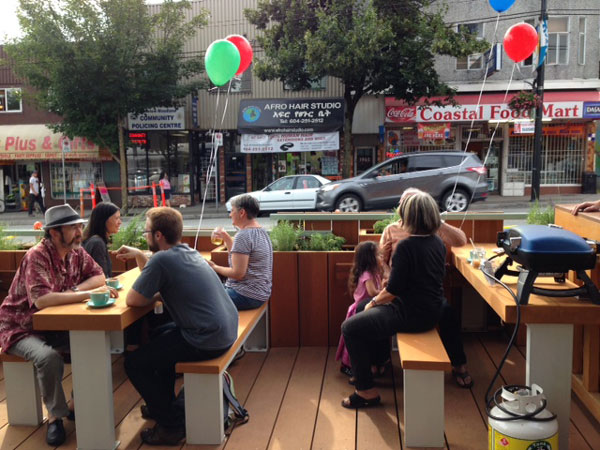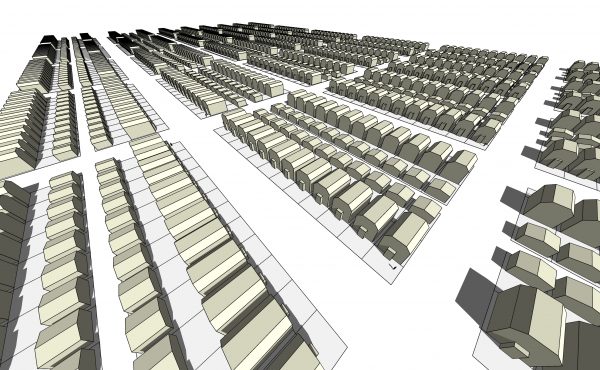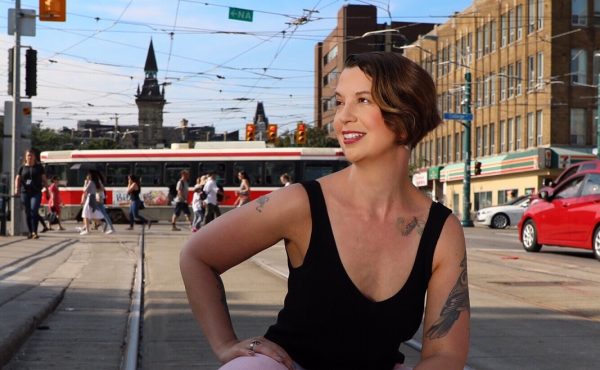
There is a new public space installation in front of Prado Café on the corner of Commercial Drive and 4th Avenue available for your enjoyment! The Commercial Drive Parklet is part of VIVA Vancouver’s Parklet Pilot Program, an initiative that supports the transformation of on-street parking into public spaces. The structure made out of wood and steel is an elegant yet comfortable space to enjoy a cup of coffee or watch people pass by.
The design takes aesthetic clues both form the interiors of Prado Café and from the streetscape of Commercial Drive. The colour and materials create a discrete connection to the coffee shop while the form of the wooden boards projecting over the planters emulates the shapes of the buildings on the street. The parklet is experienced as an extension of the sidewalk while creating a clear separation from the car traffic. The interior space contains tables and benches that offer diverse seating arrangements to be used either collectively or individually.
The Commercial Drive Parklet was made possible by a team effort between social artist Julien F. Thomas, designer Stewart Burgess, landscape architect Emily Dixon and the folks at Prado Café. The collaborative aspect of the Commercial Drive Parklet is also reflected in the way it was funded. The project is supported by combination of public and private funding as well as through a Kickstarter campaign launched in December 2013.
Most importantly, this new parklet gives the street back to people and offers a new public experience, available to all. Go check it out while the sun is out!

Panoramic view with Commercial Drive Parklet on left.

Three Parklet team members – Julien Thomas, Prado owner Sammy Piccolo and Stewart Burgess (Emily Nixon absent).

Parklet and Prado Café view from across the street.
***
Alicia Medina Laddaga is an architecture and urban designer/researcher based in Vancouver. Originally from Mexico where she studied and practiced architecture, she moved to Vancouver in 2011 to pursue a Masters of Advanced Studies in Architecture at UBC. While trying to bridge the gap between two cultures (Mexico and Canada), Alicia keeps on developing her ideas about the ways in which dynamic and spontaneous processes transform cities into vibrant urban environments.





2 comments
I walked by this parklet the other day, and would have happily sat down at one of the tables had any been free. I guess the only qualm I have with this parklet is that it does not come across immediately as a public space. The location (directly outside the Prado storefront) and user demographic (every table had a Prado coffee cup on it) suggest that it is just an extension of the cafe, which is what I would have guessed had I not been savvy to other Vancouver parklet projects. This impression, along with the sources of funding, make this parklet public in theory but private in practice, open mostly to Prado customers and more or less an extension of the cafe’s interior space, which I might argue is, in fact, an exclusive space (and private by definition). Maybe I am being harsh here, but I’d like to see more parklets that are public in practice and serve as a place of socio-economic mixing.
Hi Nathan,
Your observation exposes one of the critical questions facing the City of Vancouver and other parklet-makers right now: How to fund these kind of spaces?
Technically the parklet is 100% public space that was generously paid for by Prado, crowdsourcing and in-kind donations. Upkeep and maintenance is 100% Prado’s responsibility and on top of this they also have to pay the City an annual fee for the parklet. They are not allowed to serve directly to the Parklet or have any recognition of these efforts on the structure itself. One would expect that given this commitment of time and money Prado would be allowed to accrue some benefit beyond an abstract association with the space.
Alturism is a powerful force (this parklet was only possible due to crowdsourcing, donations and 100s of hrs of unpaid labour from the production team) and I would love to see “public in practice parklets”. However, if the 100% public parklet concept is going to become an ubiquitous part of Vancouver either the City funds these 100% public spaces or makes the economics work in some other way.
This being said you should drop by the parklet after hours…there are definitely some socioeconomically-mixed good times happening!!